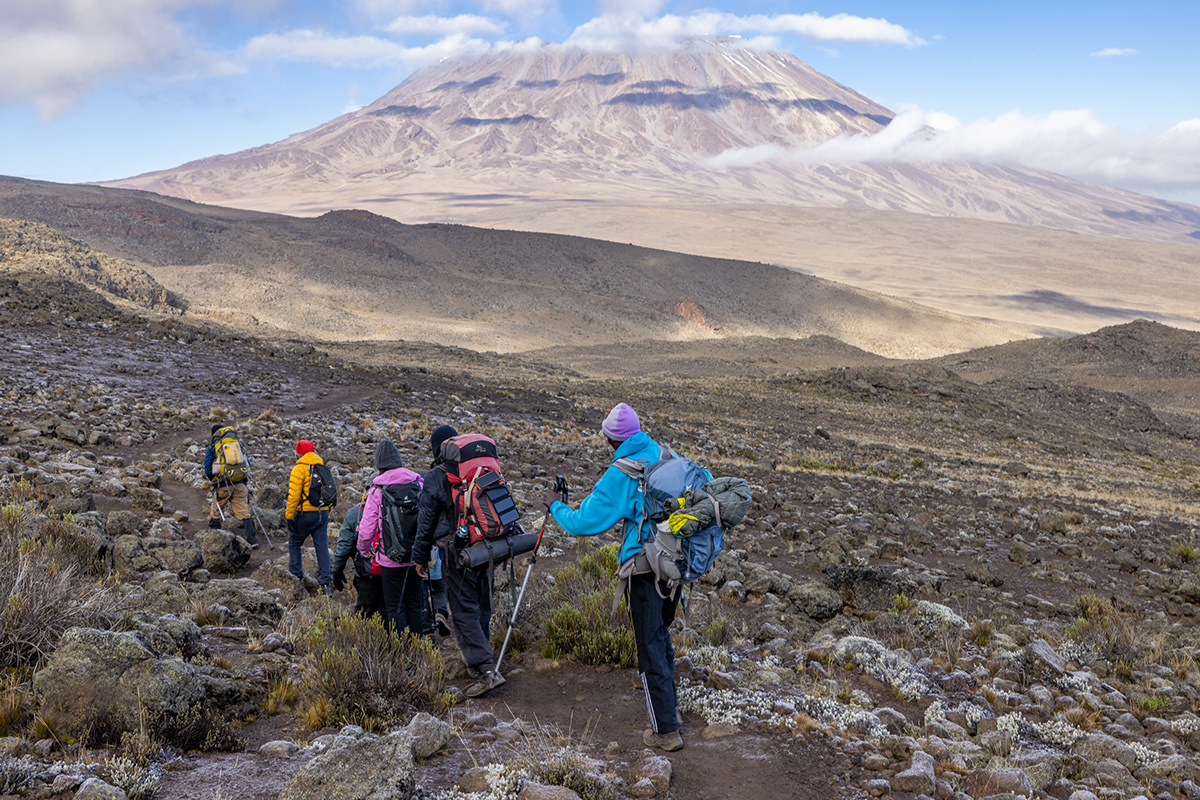
At 19,341 feet, Mount Kilimanjaro stands as a dramatic sentinel over the East African Rift Valley in Northern Tanzania, rising from lush forests into slopes of volcanic scree en route to elevations featuring ice year-round. Most visitors start their trek in Moshi, the staging ground for the major southern routes up the slope.
Mount Kilimanjaro, created by volcanic activity over 3 million years, comprises a cluster of extinct and dormant cones scoured and shaped by trade winds, precipitation, and glaciers. The massif, which is a geologically distinctive mass of rock or a connected series of masses that collectively form the summits of a mountain range, features a variety of peaks and summits. The tallest and most popular to climb is Uhuru Peak. The massif’s largest volcanic dome, Uhuru stands at the apex of the Kibo cone and is riddled with fumaroles that expel sulfuric gas.
The extinct cone Mawenzi is second-highest in the massif at 16,893 feet. It links to Uhuru through a massive barren saddle on which many trekkers camp on their first night of hiking. Mawenzi is so steep and eroded that it is considered an advanced ascent.
Most hikers choose the drier months of January to mid-March and June through October to climb Kilimanjaro. Mountain access is restricted to those with permits, so all climbers must procure the services of a trekking agency or climb operator. The mountain has seven climbing routes, the quickest taking five days. All require camping except the Marangu route, which features hut accommodations.
The most popular route, Machame, takes seven days, which allows for proper acclimatization, increasing climbers’ chances of reaching the summit. While not a technical climb (requiring full mountain climbing gear such as ropes and belay) the route is arduous and starts with a rapid ascent from balmy grasslands to Shira Camp, perched on a scree ridge at 12,500 feet. The most verdant and biodiverse landscape comes early in the hike. Colobus and blue monkeys inhabit montane rain forests, or cloud forests, which feature frequent mist and heavy rainfall and condensation, and sycamore and juniper trees featuring distinctively large moss blooms. The Mweka rainforest segment is particularly known for its giant ferns, which add a primeval, “Jurassic Park” feel to the climb.
As the trail skirts the Kibo volcano cone, expansive panoramas emerge of the plains across North Tanzania. As hikers reach the semi-alpine moorlands, an iconic woody highland sunflower plant, the Dendrosenecio, dominates. As climbers reach the lunar-like alpine plateau where they will spend most of the trek, they encounter hardy succulents, the only plants able to survive the extreme temperatures and barren soil.
The Machame route provides climbers three nights of camping at a similar elevation before a push to the rarified summit atmosphere. Even with this grace period, many climbers suffer from acute mountain sickness (AMS), a potentially fatal condition with symptoms that include headaches, nausea, and loss of appetite.
Above 16,000 feet, the landscape is likely to be covered in snow. At 19,340 feet, an Arctic zone of snowdrifts and glaciers begins, with temperatures hovering around 14 to 23 degrees Fahrenheit. Climbers must prepare for extreme precipitation, blinding snowfalls, and sudden changes in temperature. With the right preparation, most people can climb Mount Kilimanjaro, but even experienced trekkers should turn back without hesitation when the weather turns or symptoms of AMS appear.


